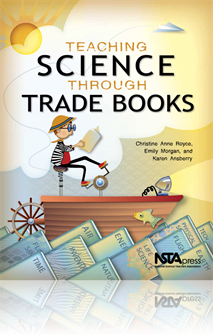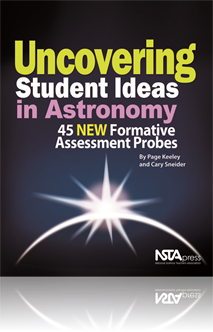All Book Chapters
Book Chapter
Weather is a topic in science that is applicable to our lives on an everyday basis. The weather often determines what we wear, where we go, and what we do. The activities here focus on clouds and the part they play in determining our weather. In the...
Book Chapter
Students probably have heard weather-based sayings, such as “March comes in like a lion and goes out like a lamb” or “April showers bring May flowers.” Throughout the ages, people have developed these and other sayings to try to predict what ...
Book Chapter
Can you measure a dog’s tail in dog biscuits? Can you measure a desk without a ruler? Which is better: measuring a room in paces or meters? Which system of measurement do scientists use? This chapter explores these questions and more to help learne...
Book Chapter
The next time you watch the Sun rise; take a minute to think about what’s really going on. You are standing on a giant ball of rock that is hurtling through space, and the spot where you are standing is rotating in the direction of a star 93 millio...
Book Chapter
From the time they are very young, children are naturally curious about the Moon. They may wonder about the different shapes of the Moon when they look up at the night sky. In this chapter's primary lesson, students discover through direct observatio...
Book Chapter
The winter months are a great time to make observations of several familiar constellations. While there’s no scientific reason to “know” the constellations—they are simply imaginative pictures imposed on stars—studying constellations can he...
Book Chapter
Just as words can tell a story, so can graphs. Pick up a newspaper or magazine and you will probably see several articles accompanied by graphs. Graphs are useful because they communicate information visually and can usually be read more quickly than...
Book Chapter
Taking Note of Natural Resources
The idea of “going green” or being aware of and reducing our impact on natural resources is receiving a lot of attention these days. Schools are starting to employ “green” practices and are soliciting help from the students to be aware of and...
Book Chapter
A notebook is perhaps the single most important piece of equipment a naturalist takes into the field. But notebooks are not only for use by field scientists: They are also excellent tools for helping students record observations outdoors, develop com...
Book Chapter
Many children have seen circus performers walk a tightrope, and they gaze with awe at their skill and ability to keep their balance and not fall from great heights. The allure of walking a tightrope and the science of balance behind it is the focus o...
Book Chapter
The purpose of this assessment probe is to elicit students’ ideas about the shape of the Earth. The probe is designed to find out how students reconcile the idea that the Earth is round, represented by the globe that they are taught about in school...
Book Chapter
The purpose of this assessment probe is to elicit students’ ideas about relative size. The probe is designed to find out how large students think the Earth is compared with the Sun. ...
Book Chapter
The purpose of this probe is to elicit students’ ideas about the changing length of daylight with the change in seasons. The probe is designed to find out if students can relate the apparent path of the Sun as seen from Earth to the length of dayli...
Book Chapter
The purpose of this assessment probe is to elicit students’ ideas about why the constellations change with the seasons. The probe is designed to find out how students use the Earth’s spin and orbit to explain why different constellations are visi...
Book Chapter
The purpose of this assessment probe is to elicit students’ ideas about when we can see the Moon. The probe is designed to reveal whether students recognize that the Moon can be seen at different times during the daylight hours as well as at night...



